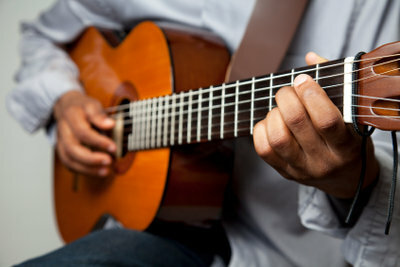Learn to read notes for the guitar
A boy enchants a crowd of young girls around the campfire with his singing and guitar playing in one summer night, it becomes understandable why many - especially young - people learn this instrument want. One of the first steps should be learning to read the sheet music!

What you need:
- Printed TABs
- guitar
What exactly is the tablature?
- The tablature, also known as TAB, is another form of writing down notes that are played with the guitar. The traditional musical symbols are not used, but an illustration of the handles.
- The TAB tells you how many fingers you have to play which string on the guitar with in order to make the chord sound.
- You also get information about acoustic features, such as slides or harmonies (see below).
- In addition, the TABs also make it clear in which mood the guitar is to be played and whether you need to attach a Kadopaster. Information about the rhythm of the piece can also be found in the tablature.
- As many advantages as this notation has, you should definitely be able to listen to the piece, because there are no statements about the exact length of the note. Otherwise it will be difficult to learn the piece in a way that it sounds good.
Learning to play notes on the guitar - this is how you do it
Do you want to learn to play the guitar without taking expensive lessons? With the …
How to read the TAB
- The tablature is based on the strings of the guitar: 6 lines symbolize all 6 strings.
- The top string is the e string, followed by the b, G, D, A and E strings, all of which are notated below. In some notations, the name of the respective page is written at the beginning.
- Now it is important which numbers are on the strings or Lines are located. These tell you which finger to play with.
- As with conventional notation, it reads from left to right.
- If there are numbers on top of each other, it means that the notes are played at the same time.
- Pay close attention to where the numbers are noted: Either the notes are played simultaneously or staggered. There are also TABs that contain such large spaces between the tones that it is no longer a chord because the first one volume has already died away when the second note is struck.
- If you read a 0, it means that the page is struck without a finger.
- The numbers represent where you need to put your finger on the guitar. For example, a 2 on the G string stands for the tone H.
- How long the respective chords are to be held can hardly be taken from the TAB, for that you have to know or at least have heard the respective piece. Reading a TAB will hardly tell you about it.
Learn markings in notation
In addition to the individual tones, you also have to learn letters that are represented in the tabs and make statements about the way you play:
- An h means "hammer on": Here you play the first note on a fret on one side and straight away then subsequently place a free finger on another fret of the same side without again to post.
- p is the symbol for "pull off", which is the opposite of "hammer on", so to speak: you put two fingers on two Strike different places on a string and shortly afterwards take the finger that is on the higher fret is away. There are two tones with one attack.
- b is the abbreviation for "bend string up": One condition is the stretching of the string. 7 b 9 means, for example, that the handle on the 7th fret has to be stretched so far that the tone of the 9th Confederation is created. In some notations, the number of the target tone is also in brackets.
- r makes statements about "release bend":
- "/" is the symbol for "slide up": Slide is the word for sliding on string instruments this style of play is also called "glissando": you slide your finger after the attack above. The number after the slash tells you how far you want to slide.
- In contrast to this, "\" is the symbol for "slide down": Here you slide your finger down after the stop.
- v or stand for "vibrato": For vibrato you have to achieve the difficult playing style by shaking your hand.
- An x means that the note should be played very heavily muted: You do not hit the chord or note with your right, but instead with your left when you pick it up. This will make the sound or Chord hardly heard. However, if the x is at the beginning of a line in the tablature, it now means that the entire string should not be struck during the chord.
How helpful do you find this article?
